
Welcome to The Great Outdoors
Be Bear Aware
It is our intent to provide information, tips and hints that will be beneficial to the outdoor person
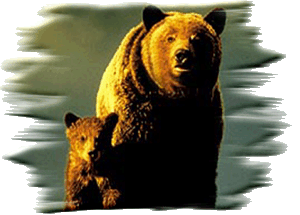
By
John William Uhler
~ Mitaku Oyasin ~
This page will cover a variety of subjects and topics pertaining to the outdoors that will help in planning an outdoor activity. If you have any suggestions or would like to contribute, please let us know.
Venturing into Grizzly Country
Thousands of people have entered into the domain of the Grizzly and have had great experiences in the backcountry with no problems. There have been some problems with bears, and we have learned from accidents, attacks and deaths in the wilderness of how to do our best to avoid them. That is what this article is all about, knowing the grizzly and avoiding an attack.
Some of the attacks have been because of human error. Two of the three deaths that I know of, were because the outdoor photographers tried to get just a little closer so they could get a really good photo. They got too close and paid for it with their lives. The third person, went into grizzly country alone against the advice of backcountry rangers. She was attacked at night in her tent and died and very little is known of what happened. A young man was attacked and mauled in June 1997 in Yellowstone and lived to tell about it. He did several things wrong to get himself into the situation and several things right to survive the attack.
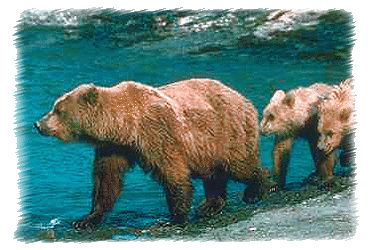 This young man went alone into Yellowstone's backcountry against the advice of rangers (first mistake). He went hiking off trail (second mistake), and he was not making noise (third mistake). When he came to the top of a small rise, there stood a grizzly sow and two cubs. He froze and did not run (good control and major rule), the sow charged him and ran past him (a bluff charge), she then came up behind him and cuffed him. When he hit the ground, he rolled into a ball and played dead (another rule). The sow came up to him and bit him on the shoulder and thigh, while he continued to play dead. The bear backed off and evidently perceived that this person was not a threat to her cubs. The bears left the area. He waited a while and very slowly and cautiously checked for the bears (another good rule). When he could not see or hear any sign of the bears, he arose and made his way back to his camp as it was just about evening. He covered his wounds as best he could and since he was not bleeding severely, he went to sleep and got up at first light and hiked out of the area and was treated for his injuries.
This young man went alone into Yellowstone's backcountry against the advice of rangers (first mistake). He went hiking off trail (second mistake), and he was not making noise (third mistake). When he came to the top of a small rise, there stood a grizzly sow and two cubs. He froze and did not run (good control and major rule), the sow charged him and ran past him (a bluff charge), she then came up behind him and cuffed him. When he hit the ground, he rolled into a ball and played dead (another rule). The sow came up to him and bit him on the shoulder and thigh, while he continued to play dead. The bear backed off and evidently perceived that this person was not a threat to her cubs. The bears left the area. He waited a while and very slowly and cautiously checked for the bears (another good rule). When he could not see or hear any sign of the bears, he arose and made his way back to his camp as it was just about evening. He covered his wounds as best he could and since he was not bleeding severely, he went to sleep and got up at first light and hiked out of the area and was treated for his injuries.
The following rules or recommendations are from years of bear studies and studies of bear attacks and the bears' nature in the wild. Remember, you are entering the wilderness at you own risk, there are dangers involved that are beyond our control. Wildlife is very unpredictable, so the following information is a general guide and will usually work in most situations, but not all. There is always the exception and wildlife have been known not to follow the rules. There are no guarantees when entering the wilderness. The better prepared you are about what to expect, the more likely you will be able to handle most situations that may arise. There is no warranty or guarantee with this information.
The grizzly bear or great bear is the largest predator in the contiguous 48 states. When you enter the bear's territory, you are in his home and he is king. This is their domain. If you know how to react when you encounter a grizzly, you have a good chance to come away alive if you follow some very sound and simple rules. It is normal and probably good to have some fear of bears, this is natural and will help us to take proper precautions to avoid close encounters of the bear kind. If you are overly fearful, you may want to just do some short hikes with some friends and not camp. If you are taking a long day hike, go prepared for bad weather and to stay overnight just in case something happens along the way, a storm or accident (twisted ankle or something). You can spend a night in relative comfort and get out the next day at first light.
Here are some rules and guidelines that have helped to successfully handle camping or hiking in the wilderness in bear country.
When entering bear territory, don't go alone. Go with at least one other person, the more people the less likelihood of a grizzly attack. There is some security in numbers. In over 100 years of its existence, the Mormon Tabernacle Choir has never been attacked by a grizzly! Although, I have to admit, I don't know that they have performed any wilderness or backcountry concerts.
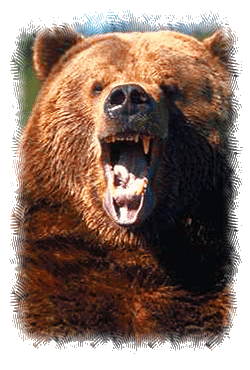 When hiking in bear country, make noise! Talk, sing and wear bear bells or something along these lines. This helps to let bears know you are there and they will normally head in the opposite direction. This will keep you from coming up on a bear and surprising him or her or them. A good number of bear attacks happen when hikers or individual walk up on a bear and surprise it. The bear doesn't know if you are a threat to them or their cubs, so they attack or bluff an attack.
When hiking in bear country, make noise! Talk, sing and wear bear bells or something along these lines. This helps to let bears know you are there and they will normally head in the opposite direction. This will keep you from coming up on a bear and surprising him or her or them. A good number of bear attacks happen when hikers or individual walk up on a bear and surprise it. The bear doesn't know if you are a threat to them or their cubs, so they attack or bluff an attack.
If you come upon a kill, get out of the area. Bears are protective of their food and will normally stay in the general area until they have finished eating the kill. This may be several days or so. You may smell the kill before you see it. Stop, check the area by carefully looking around and go back out the way you came in.
If you come upon a bear, do not make eye contact. Slowly back away so he or she can perceive that you are not a threat. The bear may stage a bluff attack and charge you and then stop shortly before it reaches you. Stand your ground, DO NOT yell at the bear and try to slowly back away. What ever you do, DO NOT RUN - if you run the bear will attack you! If there is some distance between you and the bear, and there are trees, pick a good tree and climb it. Stay there until the bear leaves the area.
Two friends were hiking on Specimen Ridge in the northeast area of Yellowstone in June 1997. As they were coming to the top of one mountain they heard the patter of feet. They froze as they tried to determine what they were hearing. Much to their surprise and dismay, two grizzly cubs were very close to them and the cubs stood to see what these two things were. My friends slowly started to back away as they knew where there were cubs there was a very dangerous sow. Again to their dismay as they backed away, the cubs walked towards them and they could now see the top of the back of the sow. The cubs advanced towards them and stood on their hind legs to get a better look. The sow saw that her cubs were looking at something so she rose to her majesty and looked at these two intruders into her territory. My friends hearts were doing some serious pumping by this time and they thought that they were in serious trouble. They did not look the sow in the eyes, they remained frozen for a while and then slowly continued to back away. Their calm very slow cool retreat led the sow to perceive that they were not a threat, she did not attack. Once they were out of the bears sight they quickly made a potty stop on the other side of the range!
If a grizzly does attack, here are some techniques that have been effective in saving lives. If you have a backpack on, leave it on, fall to the ground and assume the fetal position - roll into a ball and place your hands behind your neck. The pack will take some of the attack and if the bear bites your neck, your hands and arms will protect it as much as possible. Play dead. A good number of people who have been attacked by a bear and have handled it this way, have lived through it. When the bear stops its attack, wait a while. Listen for the bear's breathing or walking sounds . Cautiously look around, if you don't see or hear the bear, get up and get out of the area.
In the national parks, you are not allowed to carry firearms so one item to consider carrying into bear country is pepper spray. It would be an item of last resort, but it has been known to be effective in deterring grizzly attacks. Do not totally depend on it, or think you are safe because you are carrying it. Follow all the rules and precautions no matter what you are carrying. In order for pepper spray to be effective, you need to hit the bear in the nasal or facial area. This may be hard to do when a bear is attacking, (a grizzly can cover 100 yards in about 4.3 seconds). Still compared to carrying nothing and suffering a grizzly attack, I'd carry the pepper spray.
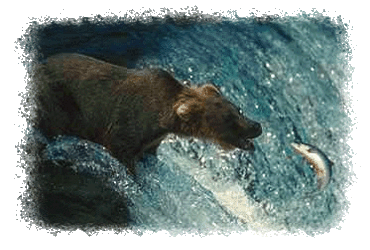 When camping in bear country, never ever take any food of any type into a tent! Unless your mother-in-law is with you, then you want to eat all meals very sloppily and store all food stuff and trash in her tent! Only kidding mom! Seriously, always eat outdoors under a canopy or open area, away from your tent or camping area and never in or near a tent. Food odors may stay in the tent, or something could spill in the tent. A bear's sense of smell is 500 times better than ours. So things that are long gone to our sense of smell may not be to a bear and you may find your tent in shreds from a bear looking for food. Food must be locked in bear boxes if they are provided. If bear boxes are not provided, food must be hung at least ten (10) feet from the ground and at least four (4) feet from the tree trunks. If a bear gets into your food, he or she will associate food with humans and become a problem bear. Problem bears that eat human food will soon become dead bears.
When camping in bear country, never ever take any food of any type into a tent! Unless your mother-in-law is with you, then you want to eat all meals very sloppily and store all food stuff and trash in her tent! Only kidding mom! Seriously, always eat outdoors under a canopy or open area, away from your tent or camping area and never in or near a tent. Food odors may stay in the tent, or something could spill in the tent. A bear's sense of smell is 500 times better than ours. So things that are long gone to our sense of smell may not be to a bear and you may find your tent in shreds from a bear looking for food. Food must be locked in bear boxes if they are provided. If bear boxes are not provided, food must be hung at least ten (10) feet from the ground and at least four (4) feet from the tree trunks. If a bear gets into your food, he or she will associate food with humans and become a problem bear. Problem bears that eat human food will soon become dead bears.
Never hike at night in bear country. Bears are normally nocturnal and they use the easiest natural trails, which are normally the hiking trails. At night, bears are looking for food. Don't offer yourself as a snack!
If a bear should attack at night, what should you do? This is a totally different situation than a surprise day attack. If a bear attacks at night, it considers you food and is determined to eat you. In a night bear attack, fight the bear with everything and anything you have, books, gear, flashlight, shoes, yell, scream, make noise, hit, kick and do whatever you can to fight the bear. DO NOT play dead or you will be! If you have pepper spray, use it. Again, most of the attacks that have happened at night and have been handled like this, the individuals have survived.
Be Bear Aware - provided by the National Park Service
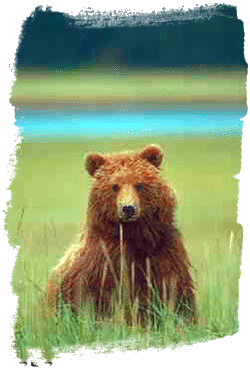
Avoid surprising animals at close range. Whistle, talk, sing, or otherwise make noise when hiking in areas where visibility is limited or bear sign present. Take no pets; they are prohibited in the backcountry. A dog's valor may turn into retreat bringing an infuriated bear to you.
Be alert to sign (droppings, diggings, fresh tracks, etc.), sounds, or other indications of bears. Be particularly wary when hiking wildlife trails, salmon streams, or other areas where bears concentrate.
Food and beverages should never be left unattended. Foodstuffs with strong odors such as fish, cheese, sausage, and fresh meats should be stored in a food cache, a bear resistant container, or suspended 10 feet above ground. Carry all refuse and garbage out! Buried refuse will attract bears.
Keep packs and other personal gear on your person. It is easy to become separated from belongings left lying on the ground when a bear unexpectedly approaches. Bears will investigate, often destructively.
Bears approach anglers because they have learned to recognize them as a source of food. Stop fishing when bears are present.
If you keep a fish, you should remove the fish immediately to a proper food storage area.
![]()
The minimum safe distance from any bear is 100 yards. These are MINIMUM distances, there are many times that greater distances are required!
Regardless of precautions taken, you may come across a bear. Usually they will run away. A bear standing on hind legs may only be trying to sense you better, not preparing to attack. Even a charge is often a bluff, ending abruptly short of physical contact.
If you see a bear at a distance, turn around or make a wide detour. Keep upwind if possible so the bear will get your scent and know you're there. Talk in an assured tone to communicate your presence. Treat animals as if cubs are nearby. Assume the bear will be defensive. Do not approach closer to scare a bear away as you may be considered a threat.
Avoid actions that interfere with bear movement or foraging activities.
Be satisfied with a distant photograph, or use a telephoto lens. Many fatalities and injuries have been related to photography.
Do not corner an animal. Allow them plenty of space and an escape route.
Bears are typically solitary animals. Much of their communication at feeding aggregations, such as occur on Brooks River in Alaska, serves to maintain spacing and avoid conflict. Bears appear to have only a limited repertoire for this purpose. These behavior patterns are not highly ritualized, as in some species; therefore, their meaning is largely dependent on the context of the situation.
Descriptions of some behavior and a general interpretation of meaning follow to help you understand what a bear may be trying to tell you. Remember, each bear is an individual and each encounter is unique.
![]()
Standing on hind legs - A bear standing bipedally is typically not expressing aggression. Bears generally stand on their hind legs to gain more information, both olfactory and visual.
Stationary lateral body orientation - A bear may stand broadside to assert itself in some instances. In encounters with human, it has usually been interpreted as a demonstration of size.
Stationary frontal orientation - If a bear is standing and facing you, it is certainly not being submissive. This is an aggressive position and may signal a charge. It is likely waiting for you to withdraw.
![]()
Huffing - When a bear is tense, it may forcibly exhale a series of several sharp, rasping huffs. A mother may also huff in order to gain the attention of her young.
Woof - A startled bear may emit a single sharp exhale that lakes the harsh quality of a huff. If her cubs woof, a mother will immediately become alert to the situation.
Jaw-Popping - Females with young often emit a throaty popping sound, apparently to beckon their cubs when danger is sensed. A mother vocalizing in this manner should be considered nervous and extremely stressed. Bears other than sows also jaw-pop.
Growl, snarl, roar - Clear indication of intolerance.
Other Indicators
Yawning - Indicates tension. This behavior may results from the close proximity of another bear or human presence.
Excessive Salivation - A clear sign of tension, salivation may appear as white foam around the bear's mouth.
![]()
The vast majority of charges are ones in which the bear stops before making contact. The intensity of the charge or associated vocalizations may vary, but it is distinct in that it is an aggressive or defensive act clearly directed at another bear or human. Bears may charge immediately, as a sow fearing for her cubs, or may emit stressed or erratic behavior before charging.
There is no guaranteed lifesaving method of reacting to an aggressive bear. Some behavior patterns have proven more successful in close encounters than others. Take a calm assured posture. A firm voice and gradual departure are better than a retreat in panic. Include the nature of your surroundings in your reaction.
As a last resort, lie face down, protect your neck with your hands and arms, and don't move. This requires considerable courage, but resistance would be futile. Numerous incidents exist where a bear has sniffed and departed without serious injury.
Hiking in nature can be very rewarding. Keep to the trail, make noise, follow the rules and have fun.
For further information and reading, check out the Yellowstone Backcountry Guide.
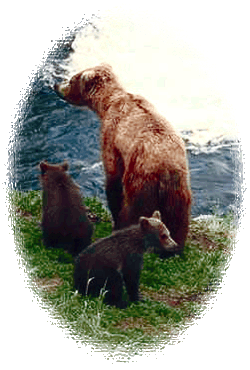 |
Check out the Calf Creek Page for information on camping and hiking in Southern Utah.
| Gold Prospecting | Videos | Trip Reports | Wildlife Gallery | Links |
| Great Outdoor Recreational Places |
| Yellowstone National Park | Great Outdoor Recreational Places |

| Other Links of Interest |

